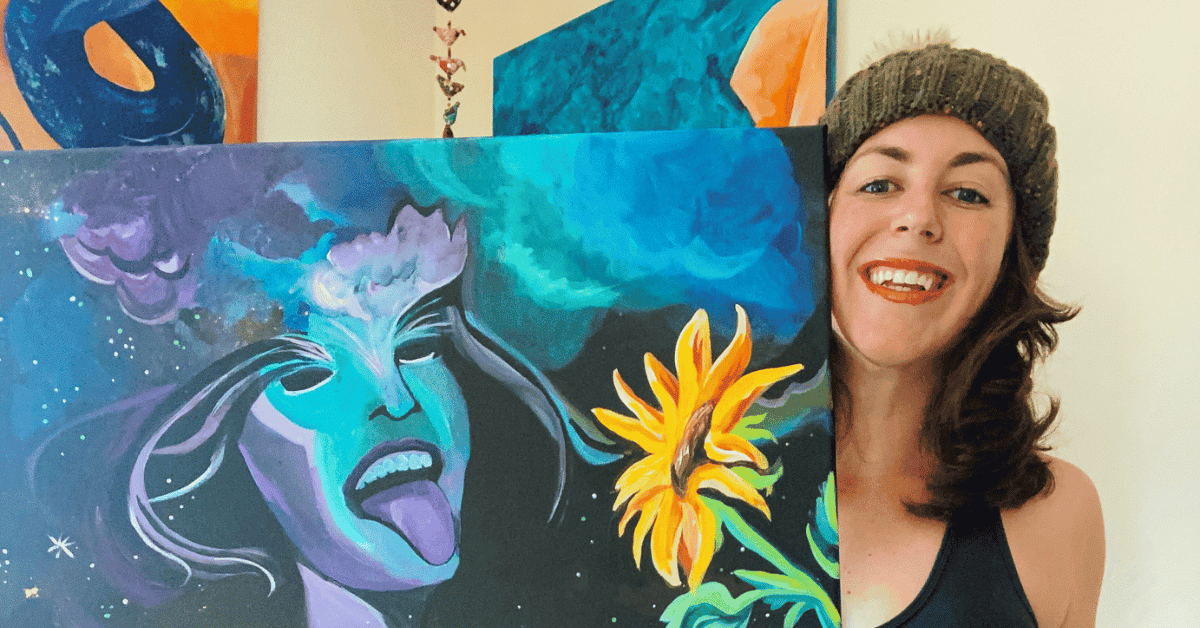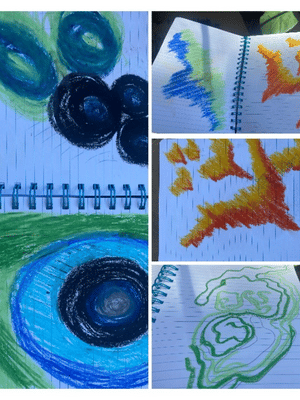As we continue to share art, poetry, and music from our community, we’re expanding the conversation by asking participants to share context about their work and how they use art in the integration process. We hope to uplift and honor our community members’ process of integration and celebrate art as a vehicle for healing. If you’d like to contribute or learn more about the project, visit our psychedelic-inspired art submissions page.
PRATI alumni Kate DeCoste, MA, LPCC, graciously shared her painting and poems for this feature, and we’re honored to celebrate her creativity and integration work. Kate is a mindfulness-based psychotherapist who specializes in cultivating secure-relationship attachment and sexuality in individuals and couples. She currently works at The Love, Sex, and Gender Center in Boulder, Colorado where she works with KAP clients.
Here is what Kate writes about her work, as well as paintings and poems she created during integration:
By Kate DeCoste, MA, LPCC
Writing, art, and painting have all been a part of my integration. This painting depicts “my essence,” which I came in contact with on my first ketamine journey and is an almost exact replica of my internal visual experience.
This painting corresponds with a poem I wrote after my first (ever) Ketamine journey, the IM session at the PRATI training:
It’s okay to move. It’s okay to breathe, fully, and loudly, to find pleasure in the way your breath takes up space in your body and expands your heart.
It’s okay to laugh, Yes, if you laugh, others may hear you. Some of them need laughter too. Permission to let go. Laugh out loud, it’s okay. You are allowed to be free.
Grandmother, thank you for dancing with me. For you big belly roles, jiggling boobs, and laughter. Thank you. I love so much how your bigness takes up space.
Since my first ketamine journey with PRATI, I have completed a series of seven personal ketamine journeys as well as started working with KAP clients at the Love, Sex and Gender Center in Boulder, CO. Somewhere along my personal ketamine journey process, I continued to dive deeper into experiences with “my essence” as well as my “self” at multiple ages and stages in my life.
Esther Perel, a Sex Therapist whose work I admire, shares that when working with victims of trauma you know they are truly healing when they rediscover their ability to reconnect with playfulness and pleasure.
This is what ketamine offered me—a chance for me to step out of my “therapist” brain and to be playfulness and pleasure. I have taken this into my work with clients.
What This Looks Like in Ketamine-Assisted Psychotherapy
These are my most recent “process” notes during my last KAP session with a client at the Love, Sex, and Gender Center. I drew these images instead of writing words on paper, as I witnessed my client in their experience. My images were directly tied to their ketamine experience and helped them remember aspects of their ketamine journey as well as deepen their integration process. (I received permission to share these.)
Trauma is not just a concept or something to be “worked” with, when we realize we can taste, touch, see, smell, and hear it in the body, it can move. Ketamine can allow us to access this knowing.
Creativity along with somatic integration allowed this to unfold. Creative expression allows me to get out of my own way, to fully understand ketamine journeys as non-linear and often non-logical. The healing has happened, for me, and many of my clients, in the felt experience within the body and within the creative process and creation of the journey.
Art as a Vehicle for Healing and Integration
We’re grateful for Kate’s generosity and thoughtfulness, and as we continue to receive submissions of art from our community we’re reminded of the power that creative process has in supporting healing. Creative expression pushes us out of our comfort zones, and in that space, we often discover insights we wouldn’t have arrived at otherwise! There are so many ways to integrate after a psychedelic medicine session, and making art or other processing outside of language can be transformative.
Thank you for demonstrating this with your art, Kate, and for your vulnerability and willingness to share your creative expression with the PRATI community! If you’re inspired by Kate’s work and would like to share your own, we’d love to hear from you. Learn more about the submission process or contact us!







